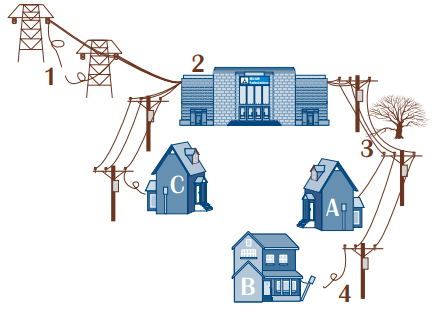The time required to restore your power depends on many variables including the cause of the outage, the number of components damaged, whether or not tree trimming is required to get to the point of repair, and the number of customers impacted. But rest assured that we will do our best to provide you with the most accurate information available, using all of the resources at our disposal to restore your power as quickly as possible.
Power restoration is not a simple undertaking; it involves an impressive coordination effort of utility crews who perform complicated tasks, often under harsh and dangerous conditions. Electricity must undergo a complex chain of events as it makes its way to your home. With more than 429,000 customers, 4,379 miles of overhead wire and an additional 450 miles of transmission lines, there is a rhyme and reason for the order in which we restore electric service.
Four steps to power restoration
While our first concern is to ensure public safety by immediately addressing dangerous situations such as downed lines, the following four steps outline the general steps in the restoration process.
Step 1: Before MLGW can supply electricity to its customers, it must be able to receive it from its supplier. Thus, our first order of business is to repair any damage to transmission lines and towers. These lines carry electricity from our producer, Tennessee Valley Authority (TVA), to our substations.
Step 2: We repair any damage to our substations to bring circuits online and focus our attention on restoring power to water pumping stations, hospitals and other priorities critical to public health and safety. MLGW has more than 60 electric substations that supply power to both overhead and underground electric distribution lines. At this stage of the restoration process, our crews may be working in remote areas that aren’t visible to the general public. Even if you don’t see our crews immediately, please be assured that we are working diligently to restore your power.
Step 3: Beginning with areas with the greatest concentration of outages, our crews focus on repairing primary and secondary distribution lines, which run through the streets and neighborhoods leading to your home. If there are trees lying on these wires, our contracted tree trimming crews must first clear the debris. In this scenario, once the distribution line is repaired and reenergized, house A will automatically have power again, but house B will not because the individual service line leading into the house is damaged, and the meter center has been pulled away from the house. House C, located on the opposite side of the street, remains without power because it is on a different distribution line, which has yet to be repaired. This explains why your neighbors across the street or down the street may have power, but you may not.
Step 4: Repairs are made to individual service lines, such as the one shown for house B (provided the meter center is not damaged or has been repaired). As you can see from the illustration, the order in which repairs are made follows the line of progression electricity takes as it comes from TVA to MLGW and finally, to you. It would be futile to reverse the process and repair an individual service line first because there would still be no power if damages exist at the beginning of the line.


